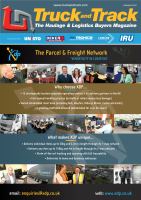

Truck and Track
June/July 2017
www.truckandtrack.com50
SAFETY & SECURITY
Unisto has been providing solutions
for the transport industry for
decades and has one of the widest
ranges
of
security
seals
and
accessories available anywhere in
theWorld.
Why should I seal my vehicles?
Security sealing is a method of access
control: it provides a clear indication of
whether the load has been accessed,
which is why these products are often
termed
indicative
seals.
There are two main reasons to use seals. The first is to protect
the load from theft. If you are using a plastic seal, this focuses on
internal theft, i.e. access to the load by transport yardworkers or the
driver when in transit to the delivery point. The second is to protect
your drivers from suspicion.
Mistakes happen when loading vehicles and, once sealed, any error
– an overlooked carton left behind in dispatch, for example – cannot
be blamed on the driver when it is discovered to be missing at the
delivery point. Most honest drivers welcome the use of a security
seal, as it puts their integrity beyond doubt and directs the spotlight
of accountability where it belongs.
So what sort of seal should I choose?
The variety of security seals on the market is huge, and their quality
varies agreat deal. Themost important featureof aplastic indicative
seal is that it cannot be opened and then resealed without leaving
clear evidence.
So who checks plastic seals for tampering?
This is a key point: if
nobody is going to check the seals, thenwhy use one at all? I’ll come
to the checking of seals later on. Here are some elements to look out
for when choosing plastic seals:
■■
The weak “break point” should be
clearly visible outside the locking
housing (see Fig.1).
■■
Freemovement should be observed
within the locking chamber when
the seal is closed. This shows that
the seal has not been superglued
or heat-welded into place after
tampering.
■■
The quality of the injection
moulding must be clean and clear
of plastic flashings that make
the seal look messy and make
tampering more difficult to detect
on inspection.
■■
The seal must be clearly marked
and numbered, and the numbering easy to read and compare to
the number on the manifest. Bear in mind that numbers can be
changed (a 0 to a 9 for example) or obfuscated, especially when
they were fairly illegible in the first place!
The first two of these elements are only available on fixed-length
seals and for transport use on roller shutter, barn doors or TIR
cords. That is the only type of plastic indicative seal we would
recommend.
An alternative to a fixed-length, tamper-evident plastic
seal would be a reusable electronic seal, where the device is
permanently affixed to the trailer or van door and uses a cable
hasp or magnetic sensors to detect openings.
Thebenefit of a reusable seal is that it avoids theneed for continuous
management (purchasing, control, issuing and disposal) of single-
use seals.
Plastic indicative seals should be used in conjunction with a
padlock, if the vehicle is to be parked up overnight or while your
driver takes a break, to prevent opportunists breaking in whilst the
truck is unattended. Alternatively, use a barrier-type steel bolt or
cable seal which is impossible to remove by hand.
Security seal management & checking regime
Always purchase your security seals from a reputable source. There
is an ISO Standard for security seal suppliers that ensure seals
are manufactured, documented and distributed under complete
control. ISO17712 came about after the 9/11 outrage, when US
Homeland Security looked at more effective ways of controlling the
supply chain into the USA. They realised that security sealing was
open to abuse by unscrupulous and low-quality manufacturers,
Fig 1: Break-point on outside of
locking housing
“
Best practice in security sealing
Expert advice to guide our readers fromDonald Miller, Sales &Marketing Director of the security seal
manufacturer Unisto Ltd
DonaldMiller
The Unisto E-Containerlock senses its environment &
alerts management to changes to a load in transit
Flatstar



















